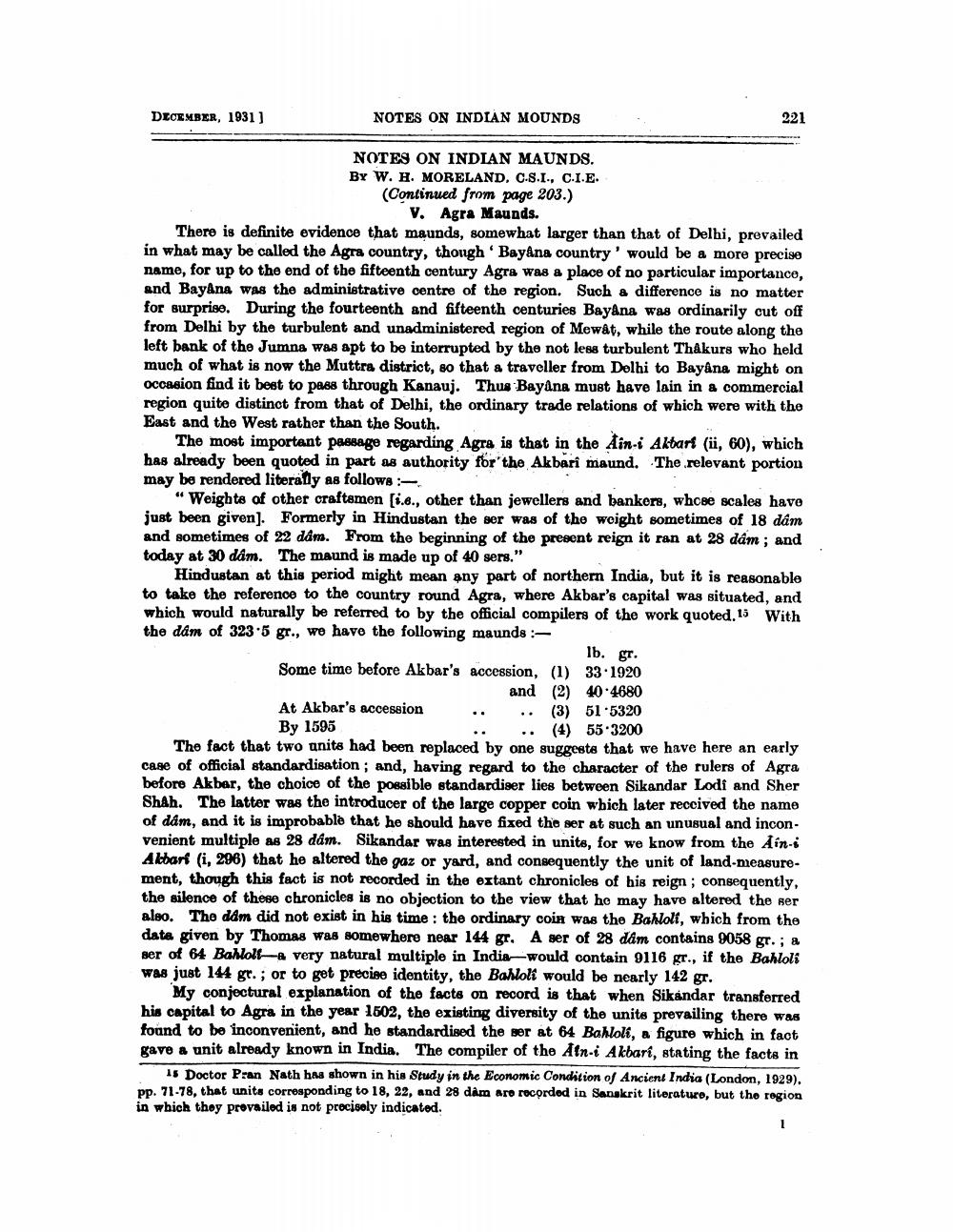________________
DECEMBER, 1931 ]
NOTES ON INDIAN MOUNDS
221
NOTES ON INDIAN MAUNDS. By W. H. MORELAND. C.S.I., C.I.E. (Continued from page 203.)
V. Agra Maunds. There is definite evidence that maunds, somewhat larger than that of Delhi, prevailed in what may be called the Agra country, though Bayana country' would be a more precise name, for up to the end of the fifteenth century Agra was a place of no particular importance, and BayÂna was the administrative centre of the region. Such a difference is no matter for surprise. During the fourteenth and fifteenth centuries Bayana was ordinarily cut off from Delhi by the turbulent and unadministered region of Mewat, while the route along the left bank of the Jumna was apt to be interrupted by the not less turbulent Thakurs who held much of what is now the Muttra district, so that a traveller from Delhi to Bayâna might on occasion find it best to pass through Kanauj. Thus Bayana must have lain in & commercial region quite distinct from that of Delhi, the ordinary trade relations of which were with the East and the West rather than the South.
The most important passage regarding Agra is that in the Ain-i Akbar (ii, 60), which has already been quoted in part as authority for'the Akbari maund. The relevant portion may be rendered literally as follows:
“ Weights of other craftsmen [1.8., other than jewellers and bankers, whose scales have just been given). Formerly in Hindustan the ser was of the weight sometimes of 18 dám and sometimes of 22 dám. From the beginning of the present reign it ran at 28 dám ; and today at 30 dám. The maund is made up of 40 sers."
Hindustan at this period might mean any part of northern India, but it is reasonable to take the reference to the country round Agra, where Akbar's capital was situated, and which would naturally be referred to by the official compilers of the work quoted. 15 With the dam of 323.5 gr., we have the following maunds :
Ib. gr.
Some time before Akbar's accession, (1) 33.1920
and (2) 40.4680 At Akbar's accession .. . (3) 51.5320 By 1595
.. (4) 55.3200 The fact that two anits had been replaced by one suggests that we have here an early Cage of official standardisation; and, having regard to the character of the rulers of Agra before Akbar, the choice of the possible standardiser lies between Sikandar Lodi and Sher ShAh. The latter was the introducer of the large copper coin which later reccived the name of dám, and it is improbable that he should have fixed the ser at such an unusual and inconvenient multiple as 28 dám. Sikandar was interested in units, for we know from the Ain-s Abbar (i, 296) that he altered the gaz or yard, and consequently the unit of land-measurement, though this fact is not recorded in the extant chronicles of his reign; consequently, the silence of these chronicles is no objection to the view that he may have altered the ser also. The dam did not exist in his time : the ordinary coin was the Banloll, which from the data given by Thomas was somewhere near 144 gr. A ger of 28 dâm contains 9058 gr.; a ser of 64 Bahlolta very natural multiple in India-would contain 9116 gr., if the Bahloli was just 144 gr.; or to get precise identity, the Bahloli would be nearly 142 gr.
My conjectural explanation of the facts on record is that when Sikandar transferred his capital to Agra in the year 1502, the existing diversity of the units prevailing there was found to be inconvenient, and he standardised the ser at 64 Bahloli, a figure which in fact gave a unit already known in India. The compiler of the Ain-i Akbarí, stating the facts in
15 Doctor Pran Nath has shown in his Study in the Economic Condition of Ancient India (London, 1929). pp. 71-78, that units corresponding to 18, 22, and 28 dam are recorded in Sanskrit literature, but the region in which they provailed is not precisely indicated.




